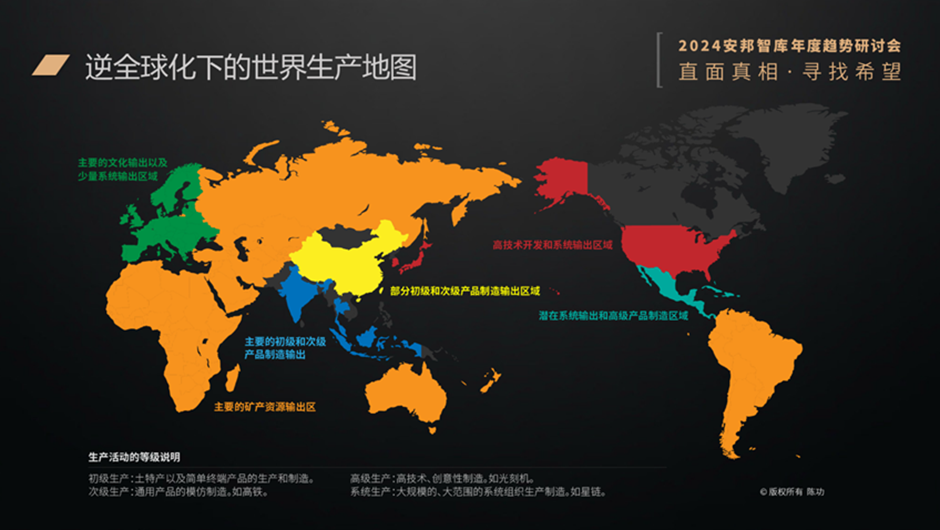Few in the past would foresee the current reality. From ANBOUND's observations and research on the fragmentation of the global market space several years ago (Kung Chan, 2018), to the current surge of the deglobalization wave, no one anticipated that its impact would be so significant, which has caused disruptions in many details of the global economy and industries.
From globalization to deglobalization, from the unknown to becoming a reality, all these are structural upheaval in the world. ANBOUND's founder Kung Chan believes that from the perspective of geopolitical games, international relations conflicts, and various other aspects, the world seems to be returning to the 1930s. This does not mean that the current situation is a replica of that era, but rather that the attitudes and positions of the societies facing major changes and structural shifts are similar to those of the late 1930s (i.e., on the eve of World War II). The characteristics of this era of change include nationalism, populist movements, left-right confrontations, geopolitical realignments, ideological resurgence, and other keywords that were overlooked during the era of globalization but have now become crucial in defining the current age.
Economically, in the era of deglobalization, there has been a significant change in the logic of economic operations compared to the past. In the past, everything revolved around the market. With efficiency as the goal, investments were free, trade was smooth, and transnational capital could search for cost advantages globally. However, now geopolitical factors have significantly intervened in economic activities. The global economic operation will now need to consider not only market logic but also geopolitical one. Reflected in the layout of the economy and industries, the past economy was centered around the market, but in the future, it will revolve around industries. When the market was at the central stage, the emphasis was on getting close to the market, even agreeing to exchange technology for market access. When it is centered around industries, the emphasis would be on the strength of industries, getting close to the manufacturing hub, and expanding the manufacturing hub, which is the "close produce model" previously proposed by Chan.
From the perspective of "close produce" and global industrial transfer, Chan believes that the shift of industries from China, the "world's factory" to countries like Vietnam and India is only a temporary phenomenon. The footsteps of multinational corporations will not cease; they will further shift industries and move them from India and Vietnam back to their "backyard". For the United States, this "backyard" is South America. In recent years, Vietnam was once the beneficiary of industrial transfers; in the last two years, Mexico has become the rising star. It remains to be seen if this phenomenon of industrial migration will continue to occur in the future.
Under deglobalization, the relocation of industries will alter the global landscape of industrial investment, eventually shaping a new world production distribution. During the recent ANBOUND 2024 Trend Symposium, Chan presented his research on the global production layout under deglobalization, which classifies global production activities into four levels:
1. Primary production: This refers to the production and manufacturing of energy and mineral resources, as well as simple terminal products.
2. Secondary production: This refers to the imitation manufacturing of general products, such as high-speed trains and automobiles.
3. Advanced production: This refers to high-tech and creative manufacturing, such as photolithography machines.
4. Systemic production: This refers to large-scale, extensive system-organized production and manufacturing, such as satellite constellations.
Based on the different levels of involvement of countries worldwide in global production activities, Chan depicted a "World Production Map under Deglobalization". Countries and regions such as Africa, Russia, parts of Eastern Europe, the Middle East, Australia, and South America are major regions for exporting mineral resources, belonging entirely or partially to the "primary production" zone. Mainland China and Taiwan fall within the areas of partial primary and secondary product manufacturing. India and Southeast Asia may become major areas for manufacturing primary and secondary products in the future. Europe (Western, Southern, and Northern Europe) holds a predominant position in global production as a major cultural output and a limited systemic output area. The United States, Japan, and South Korea could potentially become areas for high-tech development and systemic output. Certain South American countries, including Mexico, are potential areas for systemic output and advanced product manufacturing.
Figure: Global Production Map under Deglobalization

Source: ANBOUND.
It should be noted that China is the most comprehensive industrial country in the world, with a wide range of technological levels and production capabilities in manufacturing. In the industrial sector, China has a large number of "version 1.0" traditional manufacturing industries as well as some more advanced "version 2.0" and partial "version 3.0" manufacturing industries. However, from a global perspective and considering future development trends, the country can still be generally classified as a "region for manufacturing partial primary and secondary products".
Final analysis conclusion:
As deglobalization and geopolitical competition intensify, the new world production map will continue to evolve, gradually achieving a new balance in the new era. In the next world production layout, different countries and regions generally have their positions and basic divisions of labor. The cooperative relationships between countries and regions will also be influenced by this basic pattern. For China, which played a significant role as the "world's factory" during the era of globalization, its future development faces new challenges. From the perspective of the global production hierarchy, China's future development direction should opt for "systemic production".
